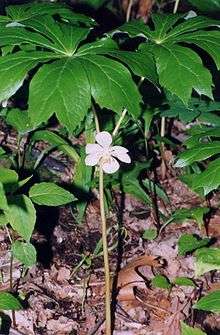Podophyllum
| Mayapple | |
|---|---|
 | |
| Podophyllum peltatum[1] | |
 | |
| Scientific classification | |
| Kingdom: | Plantae |
| (unranked): | Angiosperms |
| (unranked): | Eudicots |
| Order: | Ranunculales |
| Family: | Berberidaceae |
| Genus: | Podophyllum L. |
| Binomial name | |
| Podophyllum peltatum L. | |
| Synonyms[2] | |
| |
Podophyllum is an herbaceous perennial plant in the family Berberidaceae, described as a genus by Linnaeus in 1753.[3][4] In the past, several species were included in the genus, but all but one have been transferred to other genera (Dysosma, Pilea, and Sinopodophyllum).[5] The one remaining species is Podophyllum peltatum, with common names mayapple, American mandrake, wild mandrake,[6] and ground lemon.[7] It is widespread across most of the eastern United States and southeastern Canada.[8][9]
Mayapples are woodland plants, typically growing in colonies derived from a single root. The stems grow to 30–40 cm tall, with palmately lobed umbrella-like leaves up to 20–40 cm diameter with 3–9 shallowly to deeply cut lobes. The plants produce several stems from a creeping underground rhizome; some stems bear a single leaf and do not produce any flower or fruit, while flowering stems produce a pair or more leaves with 1–8 flowers in the axil between the apical leaves. The flowers are white, yellow or red, 2–6 cm diameter with 6–9 petals, and mature into a green, yellow or red fleshy fruit 2–5 cm long.[5]
All the parts of the plant are poisonous, including the green fruit, but once the fruit has turned yellow, it can be safely eaten with the seeds removed.[10]
The substance they contain (podophyllotoxin or podophyllin) is used as a purgative and as a cytostatic. Posalfilin is a drug containing podophyllin and salicylic acid that is used to treat the plantar wart.
They are also grown as ornamental plants for their attractive foliage and flowers.
Though the common name is mayapple,[11] it is the flower that appears in early May, not the "apple". The fruit or "apple" is produced early summer and ripens later in summer.
Many species of plants have mycorrhizae to assist with nutrient uptake in infertile conditions. Mayapple plants are considered obligately dependent upon such mycorrhizae, although it may also be facultatively dependent upon rhizome age and soil nutrient levels.[12] Plants are commonly found infected by the rust Allodus podophylli, appearing as honeycomb-patterned orange colonies under the leaves, and yellowish lesions on the upper surface.[13][14]
Toxicity
The unripe green fruit is toxic. The ripened yellow fruit is edible in small amounts, though when consumed in large amounts the fruit is poisonous. The rhizome, foliage and roots are also poisonous.[15] Mayapple contains podophyllotoxin,[16] which is highly toxic if consumed, but can be used as a topical medicine.
Medicinal use
Mayapple has been used by American Indians as an emetic, cathartic,[17] and antihelmintic agent.[17] They also boiled the poisonous root, and used the water to cure stomach aches. The rhizome of the mayapple has been used for a variety of medicinal purposes, originally by indigenous inhabitants and later by other settlers.
Mayapple can be also used topically for warts, and two of its derivatives, etoposide and teniposide, have shown promise in treating some malignant neoplasms.[18][19]
Gallery
References
- ↑ 1897 illustration from Franz Eugen Köhler, Köhler's Medizinal-Pflanzen
- ↑ The Plant List, Podophyllum peltatum L.
- ↑ Linnaeus, Carl von. 1753. Species Plantarum 1: 505 in Latin
- ↑ Tropicos, Podophyllum L.
- 1 2 Flora of North America, Vol. 3, Podophyllum Linnaeus
- ↑ USDA GRIN Taxonomy, retrieved 28 March 2015
- ↑ Plants for a Future, retrieved 28 March 2015
- ↑ "Podophyllum L.". Integrated Taxonomic Information System.
- ↑ Biota of North America Program 2013 county distribution map
- ↑ http://www.eattheweeds.com/podophyllum-peltatum-forgotten-fruit-2/
- ↑ Podophyllum peltatum at USDA PLANTS Database
- ↑ Watson, M.A. and five others. 2001. The developmental ecology of mycorrhizal associations in mayapple, Podophyllum peltatum, Berberidaceae. Evolutionary Ecology 15: 425-442.
- ↑ "Puccinia podophylli Schwein. Mayapple rust". Iowa State University, Ada Hayden Herbarium (ISC). Retrieved 2013-03-16.
- ↑ Bunyard, Britt A. 2013 "Mayapple Rust Resurrection" FUNGI 6(1): 38-39.
- ↑ Blanchan, Neltje (2002). Wild Flowers: An Aid to Knowledge of our Wild Flowers and their Insect Visitors. Project Gutenberg Literary Archive Foundation.
- ↑ Moraes, R.M., H. Lata, E. Bedir, M. Maqbool, and K. Cushman. 2002. On American Mayapple as practical source of podophyllotoxin p. 527–532. In: J. Janick and A. Whipkey (eds.), Trends in new crops and new uses. ASHS Press, Alexandria, VA.
- 1 2 Ernest Small and Paul M. Catling (1999), "Podophyllum peltatum L. (May-apple)", Canadian Medicinal Crops, NRC Research Press
- ↑ Brunton LL et al. Goodman and Gilman's The Pharmacological Basis of Therapeutics, chapter: 61. Cytotoxic agents/Epipodophyllotoxins Twelfth Edition ISBN 978-0-07-162442-8
- ↑ Lewis, W.H. and M.P.F. Elvin-Lewis. 1977. Medical Botany. Plants Affecting Man's Health. Wiley, New York. 515 p. p. 123-124.
External links
 Media related to Podophyllum at Wikimedia Commons
Media related to Podophyllum at Wikimedia Commons Data related to Podophyllum at Wikispecies
Data related to Podophyllum at Wikispecies

